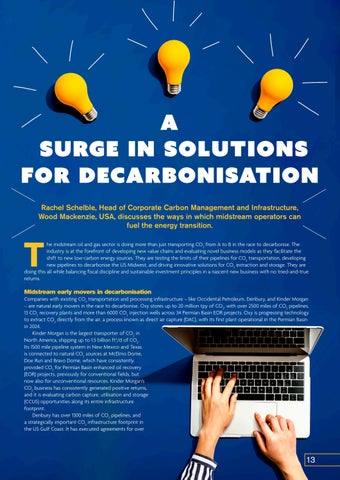Rachel Schelble, Head of Corporate Carbon Management and Infrastructure, Wood Mackenzie, USA, discusses the ways in which midstream operators can fuel the energy transition.
T
he midstream oil and gas sector is doing more than just transporting CO2 from A to B in the race to decarbonise. The industry is at the forefront of developing new value chains and evaluating novel business models as they facilitate the shift to new low-carbon energy sources. They are testing the limits of their pipelines for CO2 transportation, developing new pipelines to decarbonise the US Midwest, and driving innovative solutions for CO2 extraction and storage. They are doing this all while balancing fiscal discipline and sustainable investment principles in a nascent new business with no tried-and-true returns.
Midstream early movers in decarbonisation Companies with existing CO2 transportation and processing infrastructure – like Occidental Petroleum, Denbury, and Kinder Morgan – are natural early movers in the race to decarbonise. Oxy stores up to 20 million tpy of CO2, with over 2500 miles of CO2 pipelines, 13 CO2 recovery plants and more than 6000 CO2 injection wells across 34 Permian Basin EOR projects. Oxy is progressing technology to extract CO2 directly from the air, a process known as direct air capture (DAC), with its first plant operational in the Permian Basin in 2024. Kinder Morgan is the largest transporter of CO2 in North America, shipping up to 1.5 billion ft3/d of CO2. Its 1500 mile pipeline system in New Mexico and Texas is connected to natural CO2 sources at McElmo Dome, Doe Run and Bravo Dome, which have consistently provided CO2 for Permian Basin enhanced oil recovery (EOR) projects, previously for conventional fields, but now also for unconventional resources. Kinder Morgan’s CO2 business has consistently generated positive returns, and it is evaluating carbon capture, utilisation and storage (CCUS) opportunities along its entire infrastructure footprint. Denbury has over 1300 miles of CO2 pipelines, and a strategically important CO2 infrastructure footprint in the US Gulf Coast. It has executed agreements for over
13











